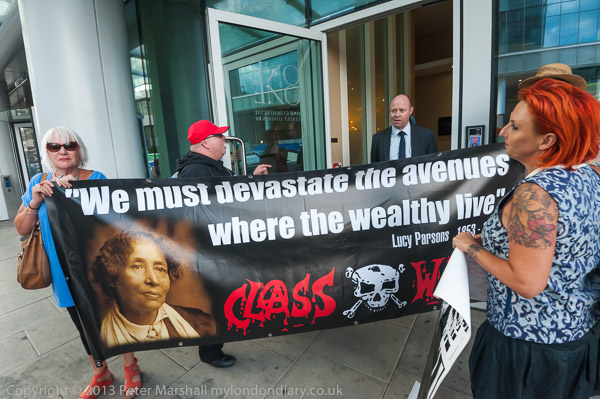I’ve just finished reading the final instalment of a series of five articles by Colleen Thornton on Paul Grottkau and Lucy Parsons published as a guest post on A D Coleman’s Photocritic International. It was a story which began by Thornton buying on E-bay a rather fine cabinet-card portrait of an unidentified African American woman, made by a hitherto unknown photographer whose name and Chicago address were below the picture.
Although Paul Grottkau was not well-known as a photographer, he had been prominent in socialist circles both in his native Germany and, after escaping to the USA in 1877 following political arrests and persecution, in Chicago where he settled, quickly becoming editor of the German language workers’ newspaper there.
Thornton goes briefly into considerable detail about his activities there, and in particular to the Haymarket Bombing in May 1886 and the arrests and execution of leading anarchists who were Grottkau’s colleagues, and were clearly unconnected with the bomb. Grottkau had by the time of the bombing moved to Milwaukee, where he had started another German language workers newspaper and become a leader in a number of strikes, including the large strike at the Milwaukee Iron Company’s rolling mill in Bay View. The National Guard fired on the 12,000 strikers and their supporters in ‘The Bay View Massacre’, and Grottkau was arrested as he tried to calm the situation by speaking to them in German. The New York Times reported Mrs. Albert R. Parsons as being in the court when he was sentenced to a year in jail (he only served 6 weeks.) Her husband, Albert Parsons was one of The ‘Haymarket Martyrs’, then awaiting execution, and hanged in November 1887. The following year Grottkau returned to Chicago to edit the newspaper again and opened a photo studio. Two years later he moved away with his family, briefly setting up studios in Milwaukee and Detroit before settling in San Francisco in 1891. There he may have worked in the studio of Joseph Holler, as well as continuing his political activities as a Social Democrat. He contracted pneumonia after returning to work for them in Milwaukee in 1898; 10,000 people attended his funeral and his obituary was published by the New York Times. But although his life-long work as an “anarchist/socialist writer, editor, labor organizer, and political activist” is well-known and documented, nothing at the time mentioned that he made a living and supported his family as a studio photographer, and very little is known about his photographic work.
Thornton was led by her research to Lucy Parsons and by comparing with the few known pictures of her, was able to establish to her satisfaction that the picture she had bought was of Lucy Parsons. Without access to the original it is difficult to fully assess the evidence, and in particular that of some fairly extensive and skilled retouching by Grottkau that Thornton discusses. She certainly makes a good case, but I am left with just a scintilla of suspicion; I’m convinced but not entirely so. But of course her research about both Grottkayu and Parsons still stands even in the unlikely event that Thornton was wrong about the photograph which prompted it.

I have a particular interest in this story as I have photographed Lucy Parsons many times in different locations, or rather her image on a banner produced by UK anarchist group Class War. What I call their ‘Lucy Parsons‘ banner has on it “We must devastate the avenues where the wealthy live” attributed to ‘Lucy Parsons (1853-1942)’. I first photographed it in July 2014 at one of their many protests against one of London’s new apartment blocks providing separate ‘poor doors’ for those living the the social housing from those in the larger private part of the building. I’ve since learnt rather more about her life and politics, but not before about some of the aspects of her life covered in this series of article.
All photographs on this and my other sites, unless otherwise stated, are taken by and copyright of Peter Marshall, and are available for reproduction or can be bought as prints.